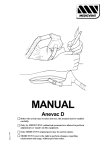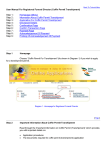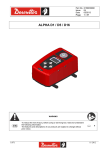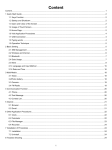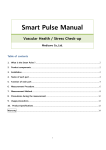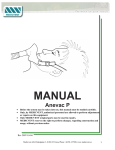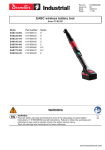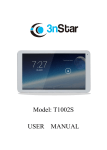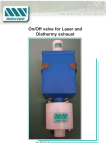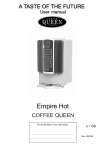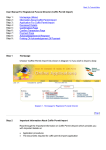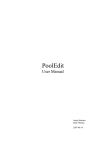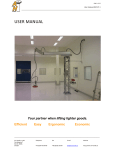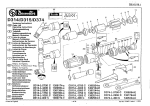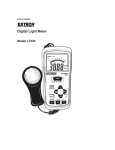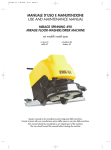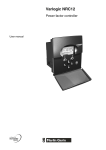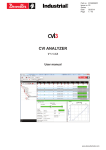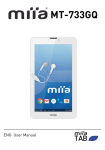Download Patovac 1999
Transcript
MANUAL Patovac + Balsavac Before the system may be taken into use, this manual must be studied carefully. Edition 1:1999 Only, by MEDICVENT, authorized personnel are allowed to perform adjustments or repairs on this equipment. Only MEDICVENT original parts may be used in repairs. MEDICVENT reservs the right to perform changes, regarding construction and usage, without previous notice. Table of contents Chapter System components Installation Trouble shooting Technical Data Page 3. 4-5. 6. 7-8. Safety 9. Balsavac (Handling & Technical data) 10. Handling Safety 11. 12. 2 System components Patovac 7 12 6 4 13 2 3 5 PATOVAC B 1 PATOVAC A 8 9 11 10 1. 2. 3. 4. 5. 6. 7. 8. 9. 10. Adapter 19/22 mm Evacuation hose (Ø 19 mm) made of hytrel Hose cap Adapter 38/19 mm Totally enclosed Mains filter (sterile) LP-10-38 Fan unit with filterwell and built in safety valve Evacuation hose (Ø 40 mm) Auxiliary cable Control box, stepless Mains cable (Euro) 11. Safety isolating transformer 12. Carriage Tillbehör: 13. Outlet valve with or without lid 150010 PATOVAC A: Oscillating pneumatic bone saw, Desoutter®. 150110 PATOVAC B: Rotating pneumatic bone saw, Desoutter®. 3 Installation Patovac Installation of stationary fan unit 1. Place the fan in a suitable location. Install the fan unit standing on it´s rubber feet, or screw it to a carriage to enable mobile use of the unit. 2. Connect the fan units outlet marked with an arrow pointing outwards to a suitable outlet ventilation. Also connect the fan units left inlet marked with an arrow pointing inwards to the outlet valve in the application room. All these connections are done through use of Extracflex installation components (pipes, angles, muffs, clips etc). 3. Connect the evacuation tube (Ø 40 mm) to the central fan units outlet valve. 4. Connect the control box to the fan unit with the auxiliary cable, through use of a 5-wired cable (Area 5 x 0,22 mm) between fan and a properly placed female DIN contact in the Controlbox Auxiliarycable 5-wired cable Fanunit This means that a safety isolating transformer does not have to be used. WARNING! A system without a safety isolating transformer does not comlpy with norm IEC 601:1. Sensitive equipment might be disturbed. 5. Connect the Mains cable from the transformer and to a suitable powersupply. 6. Connect the control box to the fan unit with the auxiliary cable. Connection patient system Stationary fan unit: 1. Attach the Mains filter (sterile) firmly through use of for example a short tube (Ø 40 mm) with muffs in both ends. These muffs are adapted to be connected to the outlet valve in the appl. room. Mobile fan unit: application room according to the picture above. ATT: An alternative is to have the control layed in into the wallpanel (app.box). Installation of mobile fan unit 1. Place the fan in a suitable location. The fan unit is mounted on a carriage to enable mobile use of the unit. 2. Connect the evacuation tube (Ø 40 mm) to a suitable evacuation device for the buildings ventilation system. 3. Connect the other end of the evacuation tube to the fan units outlet marked with an arrow pointing outwards (the right outlet seen from behind). 1. Attach the Mains filter (sterile) firmly to the hose which is located in the filterwell. The filter is kept in place on the hose with a hose clip. Insert the filter into the filterwell. N.B! A flow arrow is located on the filter which enables correct installation of thefilter. The arrow declares the flow direction the air must have through the filter. 2. Connect the adapter to the filters other end. 3. Connect evacuation hose (Ø 19 mm) to the adapter. 4. Connect the hose to the evacuation device. 5. Connect the evacuation device to the bone saw. 4. Connect the safety isolating transformer device contact to the fan unit. An exception from norm IEC 601:1 might be allowed for autopsy rooms. 4 Installation Patovac ATT: If a different bonesaw already is in use, Medicvent can normally adapt the evacuation device to this equipment. 6. Connect the Desoutter hoses to the bone saw. 7. Activate the fan with the control boxes on/offswitch. Assembly of the evacuation device to the bone saw: Make sure that the saw is turned off and that all supply connections are extracted from their power source (Pneumatic hose or Mains cable). The saw blade which is fitted to the rotating saw must not exceed Ø 45 mm. This limitation relates to the semicircular shape of the evac.-device. The shape encases a little less than half of the saw blade which means that the evac. device gets very close to the place of application. This makes for an extremely effective evacuation of all the debris caused by the saw. This limitation does not apply to an oscillating saw since the shape of the sawblade is different. The evac.-device is assembled to the bone saw by bringing it over the saw blade and then twisted on to the white adapter on the saw (In acc. to Pic.1). The fixed adapter is made of Pom Acetal and fitted with an O-ring which makes for a safe connection of the evac.-device. The instructions above applies to all bone saws modified by Medicvent. Pic. 1. 5 Handling Patovac Directions of use Clean and disinfect • Change the Mains filter (sterile) independent on activity 4–6 times/year. For hygienic reasons the filter should be exchanged at least once every three months. In reference to cleaning and disinfecting the Patovac systems components can be divided into three groups: • The Mains filter (sterile) is delivered with a lid that is put on used filters to avoid exposing the surroudings to the contents of it. • A holder for bone saw and control box can be mounted on the fan units carriage. Group 1 Decontaminator (80-85°C ) or autoclave (120°C): Evacuation hose (Ø 19 mm) Adapter Evacuation device Group 2 Washing in mild detergent (60–70° C): Patovac has no components in this group Group 3 Wipe off with disinfectant: Bone saw (N.B! Not safe to flush) Holder for bone saw and control box Saw blades Hose set Desoutter Evacuation tube (Ø 40 mm) Control box Auxiliary cable Mains cable Fan unit Carriage Mains filter (sterile) external cleaning N.B! The Bonesaw should not be immersed in water. If this has happened the saw should be run for a while to evaporate the water that might have entered the transmission. N.B! Detergent with a high pH-value might cause discolouration of aluminium. Some alcohol dissolvents might cause damages to the control box. 6 Technical data Patovac Component Material Cleaning.grp. Bone saw Anodized aluminium Group 3 Evacuation device Stainless steel Group 1 Evacuation hose (Ø 19 mm) Hytrel Group 1 Adapter Pom Acetal Group 1 Mains filter LP-10-38 Plastic Group 3 Fan unit Castings/aluminium Group 3 Evacuation tube (Ø 40 mm) PVC Group 3 Auxiliary cable PVC Group 3 Control box PVC Group 3 Mains cable PVC Group 3 Outlet valve PVC Group 3 Carriage Steel Group 3 Holder for bone saw/control box PVC and stainless steel Group 3 Hose set Desoutter PE-PUR Group 3 Saw blade Desoutter Steel/teflon Group 3 7 Technical data Fan unit Patovac Voltage feed: 220 V, 50 Hz 1-phase ±10% Current: 4 A (max) Power requirements: 0,3 kVA (max) Airflow: 45 m3/h (max) Dimensions: Height Width Depth Weight: 18 kg 400 mm 400 mm 400 mm 8 Safety Patovac WARNING! Constitutes a risk for injuries on patient and user. N.B! Constitutes a risk for damages to equipment. Only use components that MEDICVENT has delivered and/or approved. ATT: Attention, reference. Safety Patovac • Only by MEDICVENT authorized personnel are allowed to perform adjustments or repairs on this equipment. • Only MEDICVENT original parts may be used in repairs. WARNING! Observe the palpable risks of cut wounds that are always present when using a bone saw. When using a rotating blade this risk is very prominent even if the Patovac evac.device functions as a protection so that you can easily hold it in a normal twohand grip without unvoluntarily slip against the blade. WARNING! A system without a safety isolating transformer does not comply with norm IEC 601:1. Sensitive equipment might be disturbed. N.B! Be careful when removing or attaching the evac. device, for example during cleaning. The blade might break or be damaged so that vibrations arise and might also give the saw a tendency to “throw”, especially for rotating blades. N.B! A flowarrow is located on the filter which enables correct installation of the filter. The arrow declares the flow direction the air must have through the filter. N.B! The Bonesaw should not be immersed in water. If this has happened the saw should be run for a while to evaporate the water that might have entered the transmission. N.B! Detergent with a high pH-value might cause discolouration of aluminium. Some alcohol dissolvents might cause damages to the control box. ATT: If a different bone saw already is in use, Medicvent can normally adapt the evacuation device to this equipment. 9 Balsavac Handling/Technical data Installation and directions of use • The nozzle is connected to the evac. device. • The same fan unit that is used in the Patovac system is also used here in the Balsavac system. • Accessories available: A) Enclosing instrument to tighten between nozzle and body connection. B) Small mobile compressor. • A fluid separator is attached to one side of the fan unit. The fluid separator protects the fan from attacks of formaldehyde. N.B! The Fluid separator must be drained daily after use. Open the tap underneath the container. • To the fluid separator an evacuation hose is connected and on the other side of the separator another evacuation hose is connected which on the other end is connected to the filter on the fan unit. Technical data and cleaning: In ref. to cleaning there are 3 groups: Group 1 = Decontaminator (80-85°C ) or autoclave (120°C) Group 2 = Washing in mild detergent (60–70°C) Balsavac has no components in group 2 Group 3 = Wipe off with disinfectant Fan unit See Patovac Group 3 Fluid separator PVC Group 3 Holder for Fluid separator PVC Group 3 Evacuation tube Ø 40 mm, PVC Group 3 • The Balsavac consist of a stainless pressure vessel on wheels, which is filled with embalming fluid. Evacuation hose Ø 19 mm, Hytrel Group 1 Evacuation device Transparent silicon Group 1 • Embalming fluid is pumped up with compressed air from a central pneumatic system or a mobile compressor. The pressure is indicated on a pressuremeter on the vessel. Fluid gun Nickel-plated brass Group 1 Pressure reduction Brass Group 3 Pressure vessel Stainless steel Group 3 Hose from pressure vessel PVC Group 3 Enclosing instr. Stainless steel Group 1 220 V AC 50 Hz 1-phase 8kg/cm2 15 kg Group 3 • On the evacuation hose with a free end an evac. device is attached which together with the evacuation system prevents the embalming fumes from spreading in the application room. • The pressure is regulated on a stepless adjustable pressure reduction. This enables that during work you can adjust the pressure to be in accordance with the condition of the body. • To the pressure reduction a hose is connected and on the other end of the hose a fluid gun with a nozzle is connected. Compressor Voltage feed: Max pressure: Weight: 10 Balsavac Handling A. Empty all the overpressure that might be in pressure vessel. This is done by opening the refilling cap 3 Fig1 a little or a few turns (NB! the gases flowing out derives from embalming fluids. Consequently always use some form of evacuation and keep your face away from the cap). All numbers in these texts refers to Fig. 1. B. Make sure that the tap 2 is closed (The handle across the tap). Open the refilling cap 3 use the funnel to fill embalming fluids (do not fill over marking 20 on the meauring glass, cause this spoils the performance). Screw the cap real tight. If the hose with the fluid gun isn´t already attached it is done now on connection 4 (pull the shell back when the hose nipple is put in). C. The pressure regulation 5 works in a way that you lock the adjusted pressure by pushing down the handle and accordingly you release the lock by pulling up the handle. The pressure increases when you turn the handle clockwise (+) and decreases anticlockwise (-) see Fig.1. The first time you use the Balsavac you should adjust the regulation to the lowest pressure. D. Connect an airsupply to valve 1 and increase the pressure in the pressure vessel check on the pressure meter 6. N.B! Max 6 kg/cm3. If the pressure becomes too high a pressure release valve 7 will open at 12 kg/cm3. E. Open valve 2 and connect the nozzle to a suitable blood vessel. Start the embalming by holding down the button and at the same time increase the pressure until you obtain a pressure sufficient to the blood vessel. When the pressure is correct you lock the handle by pushing it down, and then go on embalming. If the pressure gets to high a pressure relief valve 7 will open at 12 kg/cm3. Fluid separator Pressure vessel for embalming fluid Evacuation device Fluid gun 11 Safety Balsavac WARNING! Constitutes a risk for injuries on patient and user. N.B! Constitutes a risk for damages to equipment. Only use components that MEDICVENT has delivered and/or approved. ATT: Attention, reference. Safety Balsavac • Only by MEDICVENT authorized personnel are allowed to perform adjustments or repairs on this equipment. • Only MEDICVENT original parts may be used in repairs. WARNING! A system without a safety isolating transformer does not comply with norm IEC 601:1. Sensitive equipment might be disturbed. N.B! The Fluid separator must be drained daily after use. Open the tap underneath the container. N.B! Max 6 kg/cm3. If the pressure becomes too high a pressure release valve will open at 12 kg/cm3. 12












